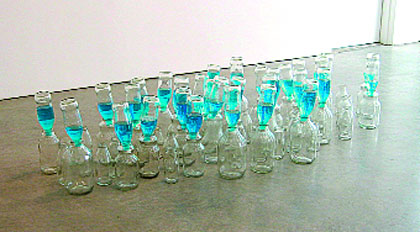With a candid perspective, Tony Fehrer rejuvenates approach to abstract art
I came away from a recent gallery hop feeling jaded. Everything looked and felt overwrought, canned, freighted with meaningless chatter—lots of production value and not much substance. In short, the experience was if I had spent the evening at XL.
Dazed by this blandness, I wandered into the refreshing tonic of Tony Feher’s show of new work—rich with light and air, poetic, playful, even romantic—like honeymooning with a new boyfriend.
True confession: I am a paint whore and I have always been flip about the “placed garbage aesthetic.” My snobbery (or envy) has really cost me something in this instance and I now regret having purposefully missed past installations of Feher’s work.
Coming out of the East Village in the early 90s with other sculptors like Felix Gonzalez-Torres, Feher has developed a similar body of work of simple construction and the sparest of means. Slow down and spend some time with a group of these pieces and you can understand the artist’s consideration of space, form, material, light, color, and sculptural touch, as well as the artist’s thoughts about the impermanence of the world.
Feher evokes all of this with a pyramid of upside down green, translucent, plastic strawberry containers (“Mountain Home, 2004”) or three stacked, lidded jars of diminishing size each holding a dusting of gold glitter (“Untitled, 2004”).
Much has been written on the gay esthetic evident in the work and the tweaking of Feher’s Minimalist/Post-Minimalist forbearers and you can go to those places—but all the gas has been let out. In another untitled piece from 2004, nine mylar potato chip, candy, and peanut bags have been hole-punched and turned inside out to expose greasy, shiny silver innards, exposing through the holes little dots of color from their now inverted exteriors. In experiencing the work in situ, the fragile physicality reveals its making and twice over exposes its insides.
Without pursuing a full-blown “read” or a big art think, I wonder if a human being could ever be so emotionally vulnerable?
I found myself simply basking in these objects; they are pleasurable and vibrant to be around. Feher builds from the familiar, the near at hand, reveling in the world around us. He is Duchampian in the very best of terms. This magpie loves the sparkle of glass and light. He will reward your attentions tenfold.


































